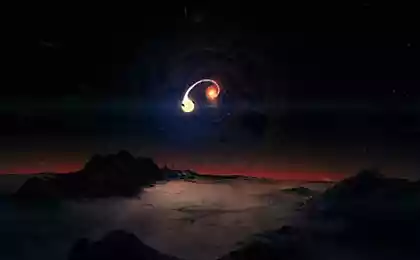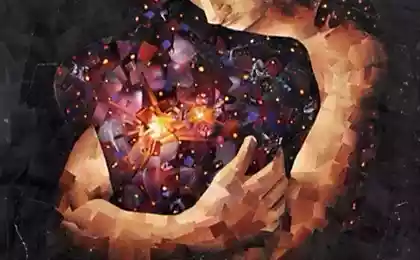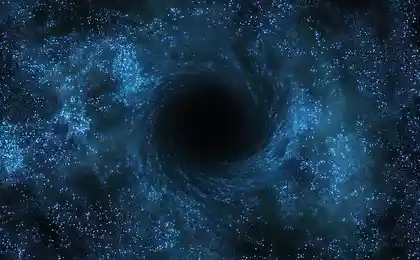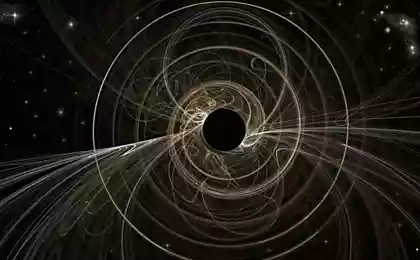1066
A new theory could answer the question: what happens inside a black hole?
There is a widespread belief that on the edge of a black hole is black move the Universe out of reality into a new realm, where the fundamental laws of nature like time no longer work the usual way. What happens when you cross the border, it remains a mystery on which the world's leading scientists think in decades.
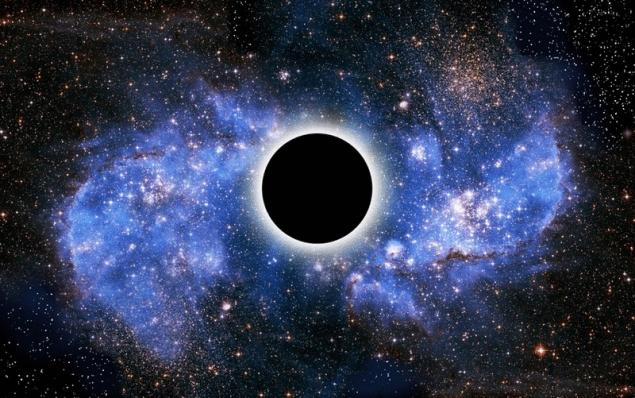
Recently in Paris was publicized work, which is to look at black holes in a slightly different way.
Taking a new approach to this old problem, a new theory postulates that, first, there is no back door to the Universe. Instead, black holes are bodies, which can not penetrate, a kind of "fluffy balls" (fuzzball). These balls are a new and black holes.
Samir Mathur, Professor of physics of Ohio state University and the sole author of the article says that as you approach the ball your body will be destroyed, but, oddly enough, you die. You will be transformed into a copy of himself, a kind of hologram that will always remain on the surface of this globe.
Mathur describes the surface as a rather vague region of space from smooth and clear structure, hence the name "fluffy ball". When he first announced his theory in 2003, it has attracted interest from the scientific community because it offered a solution to the well-established paradox of black holes.
This paradox was originally discovered by astrophysicist Stephen Hawking more than 40 years ago, and since then, scientists have tried unsuccessfully to explain it. With all this, the original calculation Mathur does not conflict with other established theories regarding black holes. Scientist spent over 15 years honing and testing your argument.
Now his latest work makes a significant step forward, suggesting that our picture of black holes as a holographic copying machine of the Universe, being very strange, could mean that these fluffy balls fully reflect how scholars must relate to a mysterious space creatures to better understand their behavior.

Some scientists are skeptical about the findings of Mathur. Although they support a new look at black holes, no one believes that you can survive when approaching the "fluffy ball": you will all perish in a fiery death.
Exotic black holes also makes them a powerful gravitational pull acting kind of deep well in space, warp space and time around and inside.
Moreover, this attraction has the right to grab whatever comes too close, including light. This means that if something fails in this well, return it can not, and this, in turn, makes it virtually impossible to determine the border of a black hole.
This has not stopped Hawking from the first attempts to find some answers in the early 70s. In contrast to Mathur, Hawking described black holes with black passages, through which material is sucked, under the action of gravity. Hawking began to explore what happens behind the door, moments before crossing the border and dive into eternity.
In 1976, he discovered studying the well installed by albert Einstein and Paul Dirac, the laws of physics, the amazing black holes don't just absorb the material through backdoors. They also emit some form of radiation.
Annoying paradoxona at the time this discovery was incredible — the radiation was named after Hawking it gave rise to the question of the so-called information paradox of black holes, which scientists dismantled so far. Mathur believes that put an end to his theory of "furry lump".
According to the theory of Hawking, Hawking radiation is generated by everything that falls into a black hole. Part of falling spits back, while the rest is trapped inside the black hole and is lost forever. Hence the paradox: one of the fundamental concepts of physics says that no matter in the Universe may not be completely lost or destroyed, which directly contradicts the original statement by Hawking. Today, scientists, including Mathur, still convinced that Hawking radiation remains the most likely component of black holes, although it still was not observed.
After 30 years, Hawking has not appeared convincing solution of the paradox, and they also open, but Mathur is. Just last scientist decided to present black holes, a solid surface, which has no back doors.
The decision information парадокса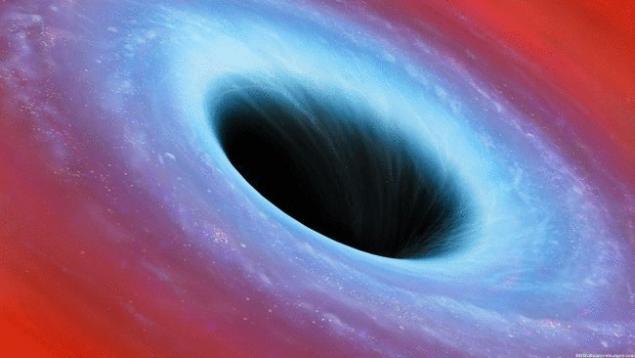
Black holes in the form of fluffy clumps, represented by Mataram are impermeable, and therefore do not have a region in which the material can get inside. Instead, any object that is pulled by the gravitational attraction of the black hole, it'll fall on its surface.
When this happens, in the form of a hologram creates an almost perfect copy of the object. This hologram begins life on the surface of the black hole, while the original copy of eats "fluffy ball".
"The original copy is destroyed. More precisely, the data components of the original into a new form in the shape data on the surface of a fluffy ball, — said Mathur in a letter to Business Insider. — When matter falls onto its surface, the surface gains energy and expands."
When matur was first learning about this theory at the turn of the century, the original calculations assumed that your holographic twin will be an exact copy of the original. However, other scientists argue that the accurate copy cannot be created because the universe strives for imperfection.
The last work of Mathur solves this problem by demonstrating how can be possible a slightly modified copy. From this point Mathur decided to bypass the information paradox of black holes in two ways:
Removing exotic component of the insides of a black hole, where it magically disappears and is permanently destroyed information. Explaining what happens to matter that reaches the black hole, as it is all stored and why nothing is lost. "The structure of the fuzzy lump resolves this paradox; for this reason, I believe that [the theory]," the scientist said.
String theory and "fluffy lumps"to explain their assumptions mathematically, Mathur relied on theoretical developments of string theory, according to which all particles in the Universe are composed of tiny one-dimensional strings that vibrate and interact with each other, creating the world around us.
(This idea itself is controversial, as nobody has seen the string. However, string theory offers a lot of convenient solutions to some unexplained phenomena and provides a convenient mathematical apparatus).
Black holes Mathur are in fact a giant spherical clusters of strings. Therefore, theoretically, when the object touches the surface of this "furry lump", its mass is converted into light, creating a holographic copy of the previous state. However, other string theorists do not agree with this interpretation.
Continuing the logic Mathur, a group of physicists at the University of California in 2012 suggested that everything that falls on the surface of the "fluffy ball" immediately "will burn in the fire" and die. The theory of such a "firewall" has divided the scientific community into supporters of the fluffy lumps and supporters of the firewall. The only way to solve this would be a scientific experiment.
"It is quite difficult to check the structure of a fuzzy ball directly from the experiment — said Mathur. One of these ways — if we are able to create tiny black holes in a particle accelerator".
Particle accelerators push particles together at almost the speed of light, and it can recreate the extreme conditions that will remind the early Universe. If the most powerful accelerator at CERN can produce black holes, it is unknown for sure.
Despite this, the group of scientists supporting the idea of Mathur, is growing worldwide. The farther into the forest, the more chance we something know.published
P. S. And remember, just changing your mind — together we change the world! ©
Source: hi-news.ru

Recently in Paris was publicized work, which is to look at black holes in a slightly different way.
Taking a new approach to this old problem, a new theory postulates that, first, there is no back door to the Universe. Instead, black holes are bodies, which can not penetrate, a kind of "fluffy balls" (fuzzball). These balls are a new and black holes.
Samir Mathur, Professor of physics of Ohio state University and the sole author of the article says that as you approach the ball your body will be destroyed, but, oddly enough, you die. You will be transformed into a copy of himself, a kind of hologram that will always remain on the surface of this globe.
Mathur describes the surface as a rather vague region of space from smooth and clear structure, hence the name "fluffy ball". When he first announced his theory in 2003, it has attracted interest from the scientific community because it offered a solution to the well-established paradox of black holes.
This paradox was originally discovered by astrophysicist Stephen Hawking more than 40 years ago, and since then, scientists have tried unsuccessfully to explain it. With all this, the original calculation Mathur does not conflict with other established theories regarding black holes. Scientist spent over 15 years honing and testing your argument.
Now his latest work makes a significant step forward, suggesting that our picture of black holes as a holographic copying machine of the Universe, being very strange, could mean that these fluffy balls fully reflect how scholars must relate to a mysterious space creatures to better understand their behavior.

Some scientists are skeptical about the findings of Mathur. Although they support a new look at black holes, no one believes that you can survive when approaching the "fluffy ball": you will all perish in a fiery death.
Exotic black holes also makes them a powerful gravitational pull acting kind of deep well in space, warp space and time around and inside.
Moreover, this attraction has the right to grab whatever comes too close, including light. This means that if something fails in this well, return it can not, and this, in turn, makes it virtually impossible to determine the border of a black hole.
This has not stopped Hawking from the first attempts to find some answers in the early 70s. In contrast to Mathur, Hawking described black holes with black passages, through which material is sucked, under the action of gravity. Hawking began to explore what happens behind the door, moments before crossing the border and dive into eternity.
In 1976, he discovered studying the well installed by albert Einstein and Paul Dirac, the laws of physics, the amazing black holes don't just absorb the material through backdoors. They also emit some form of radiation.
Annoying paradoxona at the time this discovery was incredible — the radiation was named after Hawking it gave rise to the question of the so-called information paradox of black holes, which scientists dismantled so far. Mathur believes that put an end to his theory of "furry lump".
According to the theory of Hawking, Hawking radiation is generated by everything that falls into a black hole. Part of falling spits back, while the rest is trapped inside the black hole and is lost forever. Hence the paradox: one of the fundamental concepts of physics says that no matter in the Universe may not be completely lost or destroyed, which directly contradicts the original statement by Hawking. Today, scientists, including Mathur, still convinced that Hawking radiation remains the most likely component of black holes, although it still was not observed.
After 30 years, Hawking has not appeared convincing solution of the paradox, and they also open, but Mathur is. Just last scientist decided to present black holes, a solid surface, which has no back doors.
The decision information парадокса

Black holes in the form of fluffy clumps, represented by Mataram are impermeable, and therefore do not have a region in which the material can get inside. Instead, any object that is pulled by the gravitational attraction of the black hole, it'll fall on its surface.
When this happens, in the form of a hologram creates an almost perfect copy of the object. This hologram begins life on the surface of the black hole, while the original copy of eats "fluffy ball".
"The original copy is destroyed. More precisely, the data components of the original into a new form in the shape data on the surface of a fluffy ball, — said Mathur in a letter to Business Insider. — When matter falls onto its surface, the surface gains energy and expands."
When matur was first learning about this theory at the turn of the century, the original calculations assumed that your holographic twin will be an exact copy of the original. However, other scientists argue that the accurate copy cannot be created because the universe strives for imperfection.
The last work of Mathur solves this problem by demonstrating how can be possible a slightly modified copy. From this point Mathur decided to bypass the information paradox of black holes in two ways:
Removing exotic component of the insides of a black hole, where it magically disappears and is permanently destroyed information. Explaining what happens to matter that reaches the black hole, as it is all stored and why nothing is lost. "The structure of the fuzzy lump resolves this paradox; for this reason, I believe that [the theory]," the scientist said.
String theory and "fluffy lumps"to explain their assumptions mathematically, Mathur relied on theoretical developments of string theory, according to which all particles in the Universe are composed of tiny one-dimensional strings that vibrate and interact with each other, creating the world around us.
(This idea itself is controversial, as nobody has seen the string. However, string theory offers a lot of convenient solutions to some unexplained phenomena and provides a convenient mathematical apparatus).
Black holes Mathur are in fact a giant spherical clusters of strings. Therefore, theoretically, when the object touches the surface of this "furry lump", its mass is converted into light, creating a holographic copy of the previous state. However, other string theorists do not agree with this interpretation.
Continuing the logic Mathur, a group of physicists at the University of California in 2012 suggested that everything that falls on the surface of the "fluffy ball" immediately "will burn in the fire" and die. The theory of such a "firewall" has divided the scientific community into supporters of the fluffy lumps and supporters of the firewall. The only way to solve this would be a scientific experiment.
"It is quite difficult to check the structure of a fuzzy ball directly from the experiment — said Mathur. One of these ways — if we are able to create tiny black holes in a particle accelerator".
Particle accelerators push particles together at almost the speed of light, and it can recreate the extreme conditions that will remind the early Universe. If the most powerful accelerator at CERN can produce black holes, it is unknown for sure.
Despite this, the group of scientists supporting the idea of Mathur, is growing worldwide. The farther into the forest, the more chance we something know.published
P. S. And remember, just changing your mind — together we change the world! ©
Source: hi-news.ru


